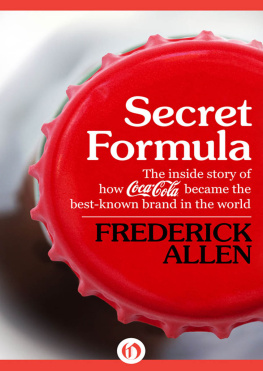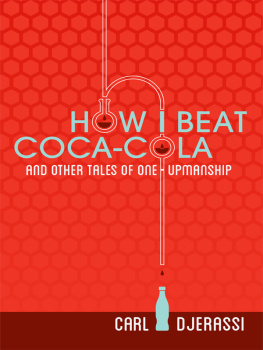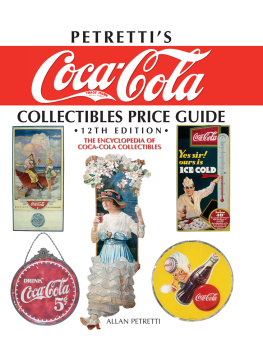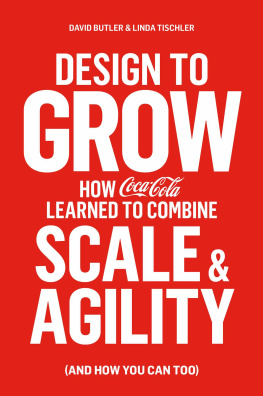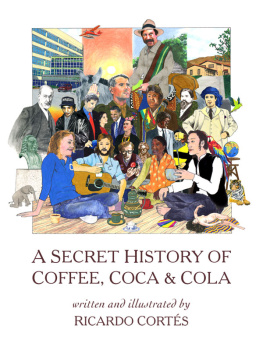Secret Formula
FREDERICK ALLEN

This book is dedicated to my mother,
Martha Cherrington Allen,
who gave me a love of words and ideas and storytelling.
CONTENTS
Introduction
RED SCARE
Prince Alexander Makinsky, the Coca-Cola Companys legendary man in Paris, was losing ground quickly.
In the winter of 1950, the French government threatened in all seriousness to outlaw the sale of Americas leading soft drink. Makinsky, a Russian aristocrat with a reputation for limitless charm and guile, took charge of the companys defenses. Born in Persia in 1900, raised in Baku on the Caspian Sea by a British nanny who taught him flawless English, educated in Moscow and Paris, Alex Makinsky was a formidable character. Hed spent the years before World War II working for the Rockefeller Foundation as a political operative in France, Portugal, and the United States, making no secret of his close ties with American intelligence. During the war, he helped scientists escape German occupation and flee to the West by an underground route through Lisbon.
At a dinner party in 1946, Makinsky asked the guests in his Paris apartment if he should accept an offer to become Coca-Colas top overseas lobbyist. I was the only one who voted no, he joked breezily afterward, so I took the job.
Makinsky began traveling for the Coca-Cola Company to hot spots in Europe, the Middle East, and South America. With his tidy moustache and tailored suits, wearing the sort of heavy-rimmed glasses that his good friend and neighbor Coco Chanel made famous, he was the very picture of worldliness, as familiar with diplomacy and protocol as a foreign minister. Makinsky prided himself on knowing monarchs and heads of state on a first-name basis. He counted many of them, from Franco to Farouk, as personal friends. Holding court in the elegant back bar of the Ritz Hotel, across the Rue Cambon from Coca-Colas Paris office, Makinsky loved to smoke slender, elegant cigars, sip champagne, and weave intrigue.
Ordinarily, a showdown with a government was the sort of challenge he welcomed, but this one was different. An unlikely coalition of Communists, winemakers, and intellectual conservatives were united in a desperate struggle to keep Coca-Cola off the French market, and the ferocity of their attack had left Makinsky shaken. The problem was not the product itself. At the moment, the company was selling only a few hundred cases a year in all of France. The average Frenchman in his corner cafe, accustomed to the familiar smells of anisette, strong coffee, and Gitanes cigarettes, had never so much as tasted a cola.
It was more the idea of Coca-Cola that triggered the trouble. Thanks to its familiar red logo and all-American image, Coke had become the lightning rod for a surge of resentment against the United States all across Europe and particularly in France. Makinsky worried that Coke frightened not only our competitors, but also the great majority of French citizens who do not want to be Americanized, and who consider our advertising as representative of what an Americanized Europe is likely to offer.
By early February 1950, five separate ministries of the French government were conducting investigations of Coca-Cola. Turning up the heat, customs authorities suspended the companys import license, and the police brought criminal fraud charges against Coca-Colas bottlers in Paris and Algiers. Most ominous of all, the secret police began shadowing Makinsky and his top deputies. Investigators in the French Interior Ministry opened dossiers on them, and there was evidence that someone was tapping Coca-Colas office telephones and intercepting the mail. One of the companys Parisian lawyers, Pierre Gide, grew so frightened he started using an alias when he called the office.
In an especially chilling incident, Makinskys number-two man, Alfredo Schvab, got a phone call at the office one afternoon from his wife. A man claiming to be Schvab had called the headmistress of the school where they sent their ten-year-old daughter, Isabelle, and made arrangements to pick her up after classes and take her to the cinema. Suspicious, the headmistress had Isabelle peek out the window from behind a curtain when the man drove up. No! the girl said. Thats not my father. As the headmistress and a teacher hid Isabelle inside, Schvab raced to the school just in time to see a sedan pulling away. He got the license number, and a contact in the police department told him it was a counterfeit plate used by a roughneck element in the Communist Party.
Unsettled by the events, the usually buoyant Makinsky warned Coca-Colas top management that the company was in imminent peril of losing the battle of France.
In Atlanta on the afternoon of Friday, February 10, 1950, Pope Brock considered the latest bad news from abroad.
As Coca-Colas general counsel, the gray-haired, sixty-one-year-old Brock had the unhappy duty of deciding what to do next. A defeat in France, he knew, had the potential of derailing the companys ambition to become a worldwide business. In the years after World War II, Coke had expanded its presence to seventy-six countries, but in most of them it had only a fragile toehold. Its operations in many places were laughably rudimentary. The field man in Colombia, for instance, put $28 on his expense account after he had to buy sneakers for his barefoot sales force.
In the past year, Brock calculated, less than a quarter of the companys $230 million in sales had come from outside the United States. Foreign profits were a meager $3 million. Coke faced intense resistance almost everywhere from the producers of beer, wine, aperitifs, fruit juices, mineral water, and other soft drinks. Every region seemed to have a domestic beverage whose owners were rich and politically well connected, and who made mischief for Coke in the courts and regulatory agencies. If the special interests in France succeeded in banishing Coca-Cola, the dominoes would begin to fall. Europe might be lost for a generation.
The looming disaster in France rattled the top men in Coca-Cola Export, the companys overseas arm headquartered in New York. Much to Brocks disgust, they were issuing memos expressing alarm and warning that it might be a grave mistake to press ahead.
Like many of the Georgia-born executives at Coca-Colas boxy, Spartan home office on Plum Street in Atlanta, Brock viewed Export as a maverick operation whose officers got to Manhattan, developed airs, and began to fancy themselves just a little better acquainted with the ways of the world than their country cousins. After growing up dirt poor in the little hamlet of Avalon, Georgia, and working his way through college and law school, Brock carried an ample chip on his shoulder, and his contempt for his counterparts at Export was thorough. He had a particularly dim view of the president of Export, Jim Curtis. A fellow Georgian, Curtis had gone native in Manhattan, and his principal hobby was symbolized by the Stork Club ashtray he kept on his desk. Brock understood the dire prospects in France, but this was not the time for panic or self-protection. It was time to show some gumption.
Brocks rumpled appearance, spectacles, and gentle drawl concealed a belligerent temperament that now rose bristling to the surface. The moment had come, he decided, to get off the defensive, raise the stakes, and bring the French affair to an end, win or lose.
All that Friday afternoon and again on Saturday morning, Brock was on the phone, rallying Coke officials in New York and Paris. Brock confided in a memo how he harangued Curtis and Roy Jones, the two top officers of Export: [I] urged upon both of them the tremendous importance of doing everything humanly possible to win the war that is now going on in France. In war, Brock reminded them, the only rational thing is to throw all of your strength and all of your resources into it.

